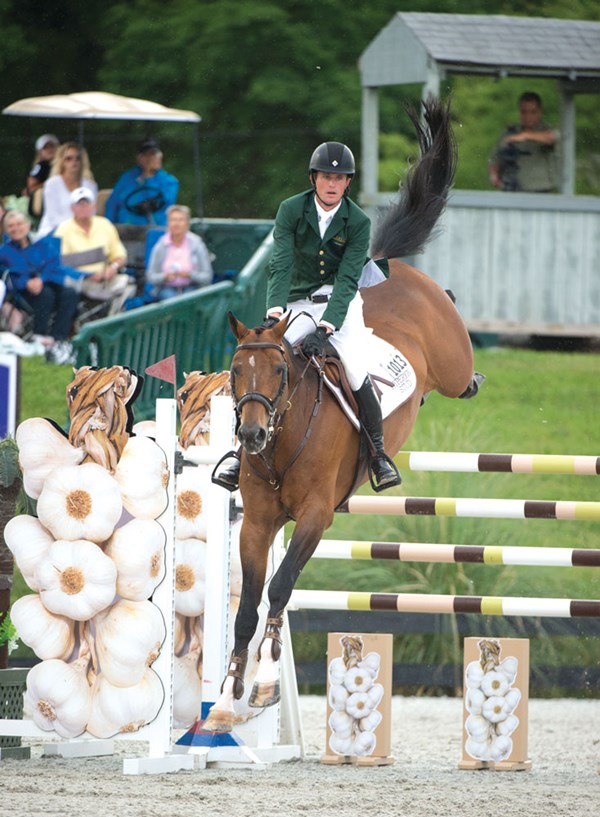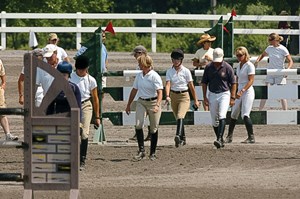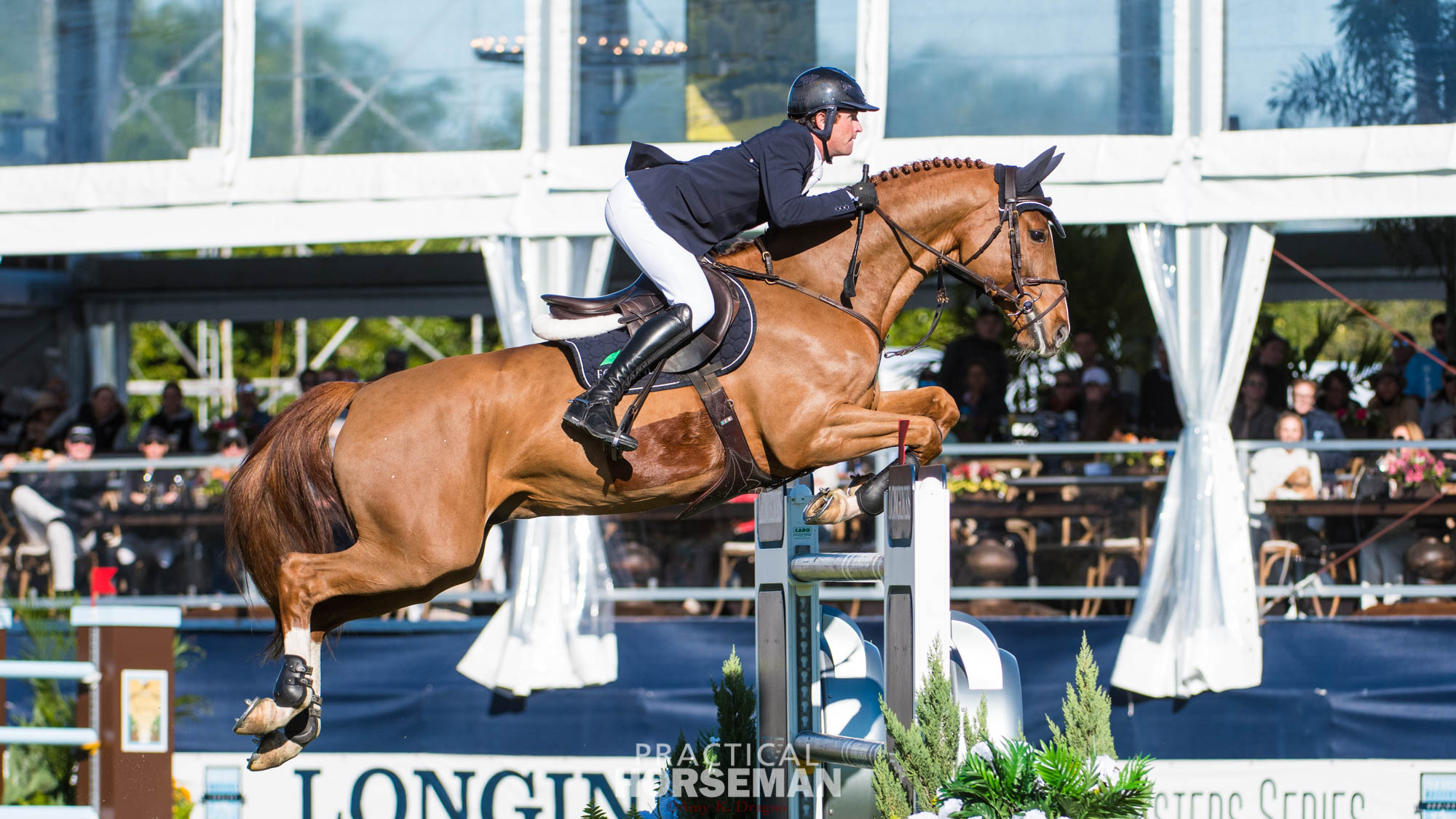
U.S.-based Irish show jumper Darragh Kenny had a spectacular year in 2014, winning 44 classes and riding for his homeland’s team in the Alltech FEI World Equestrian Games in Normandy, France. The 27-year-old—known for his speedy jump-offs—moved into the top 35 of the world rankings. Here he explains what goes into a winning jump-off round.
1. Know Your Goal
There are many strategies to consider in approaching a jump-off and the first is thinking about your priorities. Maybe you want the blue ribbon, but you shouldn’t ride every jump-off to win. For instance, consider whether you are building toward a more important class later that week or later in the season. If so, rather than trying to win that first jump-off class, focusing on jumping a clear and maybe slower round and keeping your horse confident to prepare him for the bigger class might be smarter. Going fast affects some horses. If your horse sped around the jump-off the last time he was in the ring, he may think about that again the next time he enters the in-gate. Then it can be hard to keep him together and jumping his best.
Or maybe you’re halfway down the order of go in a large group in the jump-off and there’s only one clear round by the time it’s your turn to ride. Instead of taking a massive shot to win that may or may not pay off, you might think, “I’ll just jump a clear round and end up third or fourth, which is a good prize-money check.”
2. Walk the Course
After walking the first-round course of a class, you need to walk the jump-off course separately before leaving the ring. I walk the jump-off lines a little differently than I did for the initial round, figuring out how to take a faster route and leave out strides to save time. I’ll also walk longer lines that I sometimes wouldn’t for the first round—like an unrelated bending line that I just ride off my eye in the first round. This helps me determine the amount of strides that are possible and whether the line comes up in an even rhythm.

Riding the first round, you don’t want to think about the jump-off. After it, though, consider what the lines were, how they rode and how that will affect your jump-off trip. You can’t walk the course again after the first round, but from walking the jump-off course before the class, you’ll have an idea about what you thought you could do and how various lines actually rode. At that point, I put the two together and come up with what I hope is the best plan. For instance, a line may ride shorter than it walked, so that tells me that in the jump-off I can do one less stride than I originally believed. If a line rides much longer, though, I think, “OK, there isn’t one less stride.”
3. Understand Your Horse
You have to know your horse and how good he is against the clock and what his limitations are. Is he better at turning really tight but can’t gallop that much or does he gallop well but not like to turn tight? The answer to those questions will determine your plan in the tiebreaker. Once, after I rode terribly in a speed class, I spent the next day jumping a pole on the ground with all of my horses. I rode a figure eight over it about 100 times, trying to figure out the best way to get each horse to turn, how tight I could turn him and how far away from the fence I needed to leave for him to jump his best.
If you go later in a jump-off and have been able to watch what other riders have done to save time, think about your horse and what he does. You can’t simply follow what someone else has done without considering your horse’s abilities, which likely will be different than those of the horses you have just watched. Remember that the fastest route isn’t always the most conventional route.
4. Keep Him Relaxed In the Warm-up
When warming up for the jump-off, I normally don’t try to get horses thinking about going into a tiebreaker because they can get too aggressive and jump flat. Instead, I try to keep them relaxed. I’ll do a bit of a short turn to a fence maybe once just to see how they react. The last jump I do, however, is always calm and out of a normal pace so they don’t think about going too fast when they’re headed into the ring for the jump-off.
5. Stay Smooth
If you watch top riders like McLain Ward, Kent Farrington, Beezie Madden and Laura Kraut in the jump-off, they look so in control. Smoothness and staying calm are key when riding for time. Thinking about going fast, some riders lose control. You have to stay calm and try to be fast, but the fastest way around a course is going smoothly. You see a lot of people who go fast then slow down, then speed up. They are pulling and pushing so much that they end up slower. McLain and Kent can be so fast because they’re so smooth. They keep their horses in one rhythm throughout the entire jump-off. I watch hundreds of videos of these riders, and their rhythm never changes. They win by riding smarter, for instance doing tighter turns.
In addition, their balance and their horse’s balance are always in the right place. If you land out of balance, you can’t turn as fast as someone who is riding in balance. Balance is key for making good turns, which are vital if you want to win.
6. Plan Your Turn To the Jump
Before turning to a fence in a jump-off, you have to look at the jump to see the distance you want, rather than turning and trying to fix the distance. Even if you see a distance and the track gets you to the jump at a severe angle, keep your horse really straight at that angle and he’ll have a better chance of jumping than if you tried to fix the angle just before the fence.

You also have to figure out how tight you can turn to jump. In a jump-off, the horse’s momentum is much faster, so you have to take off with a little more space in front of the jump to make it easier for your horse. Don’t take off as close to the jump as you do in the first round.
Whether it’s a vertical, an oxer or an in-and-out makes a huge difference. Obviously, you can’t turn as tightly to an oxer because it’s much wider. A vertical is easier for them to jump so you can turn a little bit tighter to that, depending on what suits your horse the best.
With in-and-outs, you need to think about jumping each element at a time. You jump A, then focus on B and go to your next jump. You’re carrying more pace when you’re going faster, so you’re going to have a bigger stride. If the double is very short, you have to slow down before the fence even more than you did in the first round. If it’s a very long distance between A and B, horses are going to find it easier than in the first round because they’re carrying more momentum.
7. Plan Your Turn After the Jump
As you land from a jump, try to turn as tightly as you can without affecting the rails. You want your horse to get as much of his body as possible over the jump before starting to turn him. If you turn in the air, he may knock it down. Keep his balance the same over the jump so he doesn’t feel any movement from you and knock the jump down.
8. Put on the Pressure
Going early is a disadvantage because you can’t watch others ride the course and you also don’t know what time you have to beat, so it’s difficult to figure out the kind of chances you have to take to win. But if you have a really good, quick round, you can put so much pressure on the other riders that they’ll have faults. McLain and Kent are good at this. It doesn’t make a difference whether they go first or last. From their equitation experience, I think they learned to leave out strides in a line without making the horse go much faster. When I worked for jumper and equitation trainer Missy Clark for four years, I did hundreds of equitation lessons and learned a lot about that from her.

9. Stay in Control in a Speed Class
A one-round speed class isn’t very different from a jump-off, although in a jump-off you can start really forward because you have only six or seven jumps. In a speed class, you have to start with a little more control and build as you go because you have more fences to jump. Over 10 jumps, a horse has more chance of getting flatter than over six or seven fences.
10. Settle Him after A Jump-off
Many horses get excited when doing a jump-off to the point where you have to try to put them together a little on the flat the next day so they’re relaxed, calm and listening to you again. Or some horses get rattled by going fast in a jump-off. How do I get them back on track?
One of my favorite exercises for many purposes involves cantering over poles on the ground. You will never put too much pressure on a horse with poles on the ground. I use them to fix a lot of issues, and it works. I lay out three poles with comfortable, evenly spaced distances between them on a straight line, and then ride over them in different strides—going forward and coming back—so the horse is listening to what I want him to do.
Riders have their own methods. I like to set the poles four to five strides apart or five to five strides. From watching Beezie Madden, I see she likes to do three strides to three strides. You can do what suits you and your horse. It’s just about changing the pace—going faster, then slowing down and speeding up again over the poles to re-establish that your horse is listening to you.
You also can use poles on the ground to teach the horse what’s going to happen in the ring. He has to know that when I turn back to a fence and put my leg on him, he must react and go forward or when I turn back and slow down, he needs to stay slow.
Even the top riders in the world don’t win every class, so don’t be too hard on yourself when you’re not winning. The percentage of classes you’re going to win, compared to the number of classes in which you compete, is very small. While you have to be critical about your own riding and yourself, you can’t do it so much that you wind up knocking your own confidence. The reason you do well is because you have so much belief in your own riding. You believe you can do something that causes others to worry about knocking down the jump if they try the same thing.
Riders go on and off hot streaks. When you start to win, you generate a massive amount of confidence and you get away with things that you might not have been able to finesse another time. But when you have a rail down, you have to look at yourself and say, “Maybe if I had done this better, he would have jumped it clear.” The key to a lot of top riders is that they look at themselves first and see what they could have done better before they blame the horse.
About Darragh Kenny
The son of Irish trainers Catherine and Michael Kenny, Darragh Kenny won a lesson with an American trainer in 2007 after finishing first in a special class at his native Ireland’s famed Dublin Horse Show. He was set to redeem his prize by working with Missy Clark when he had an accident and was out of action. Two years later, he finally was able to keep his appointment with Missy and then went on to ride with her and her husband, John Brennan, for four years.
After working with trainer Don Stewart, for whom he rode hunters and jumpers, then starting his own business, Oakland Ventures LLC, Darragh competed a succession of horses who gave him a reputation as a steady winner and one to watch whenever he’s going against the clock.
Now based in Wellington, Florida; Darien, Connecticut; and Weert, the Netherlands, Darragh’s goal this year is to be part of the Irish team for the European Championships. A top-three finish is a must for the country to qualify for the Rio Olympic Games. He has amassed a string that includes Quiz, Gatsby, Sans Souci Z and Imothep, his WEG ride and 2016 Olympic prospect.
This article originally appeared in the June 2014 issue of Practical Horseman.











